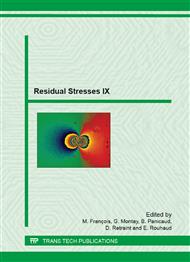p.289
p.295
p.301
p.307
p.313
p.319
p.325
p.331
p.337
A Measuring and Evaluation Program for the Application of the Ring-Core or Hole-Drilling Method
Abstract:
There is a strong need for reliable residual stress measurements. On the one hand, residual stresses can be beneficial, when they are adapted to external loads. On the other hand, they can be detrimental, when they are unknown. Thus, their occurrence can lead to an uneconomical oversizing of components or in their failure, as well. Apart from diffraction methods, mechanical methods are well recognized in order to determine unknown residual stress states. Depending on the applied method, specific boundary conditions have to be taken into account. In the case of mechanical methods like the hole-drilling and the ring-core method, the characteristics of the geometry of the component should be in accordance with an ideal and thick plate. The reason behind is the need for a calibration data set to transform strains into stresses. The calibration is usually carried out numerically. For the sake of simplicity, the geometry of the component is an ideal thick plate and the hole is introduced in its center. However, in most cases, this is not identical with the geometry of the component under investigation. Hence, an application tool was designed that enables the parametric design of a Finite Element Model, the determination of calibration coefficients, the evaluation of the experiment and the visualization of the results for geometries of practical importance. So far, the application tool can represent plates variable in their geometries and in positioning of the point of measurement. The option for other geometries are also possible e.g. a turbine blade.
Info:
Periodical:
Pages:
313-318
Citation:
Online since:
August 2014
Authors:
Keywords:
Permissions:
Share:
Citation:


